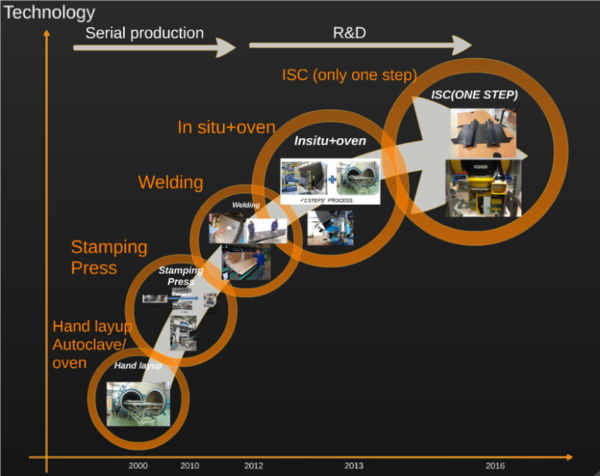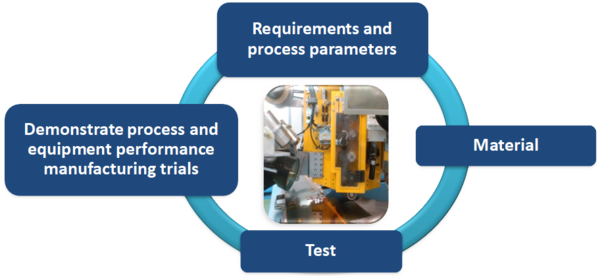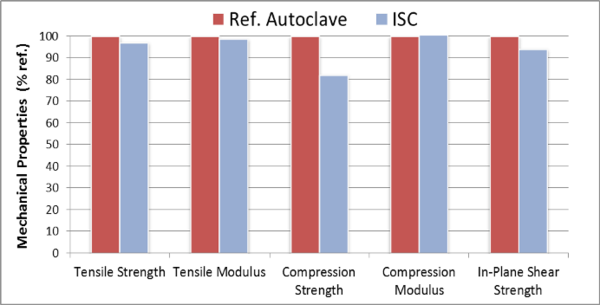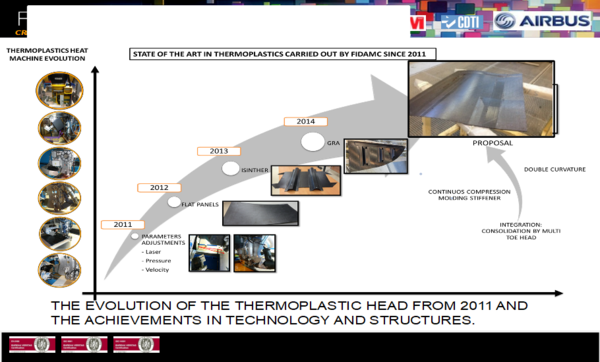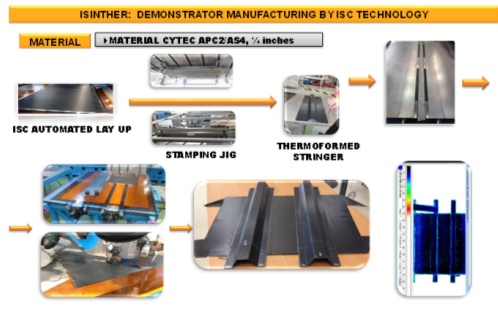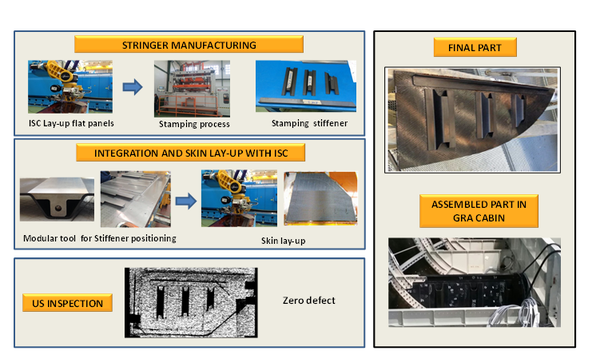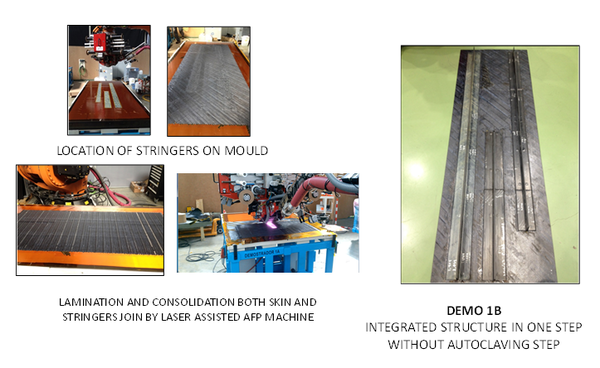1 Introduction
The use of thermoplastic matrix in carbon fiber reinforced components has been growing continuously in automotive and aerospace applications. These composites are becoming the material of choice for replacing traditional metallic materials because higher strength to weight ratios, better chemical and impact resistance and design flexibility. The future market of thermoplastic components will increase in the next years.
Besides thermoplastics have recognized aspects such as excellent FST (Fire, Smoke, and Toxicity) properties, higher mechanical properties, damage tolerance and inherently superior fatigue performance, chemical resistance, infinite shop life, weldability, reuse of material and shorter manufacturing cycles compared to their competitor thermosets. Thermoplastic resins offer a high potential not only regarding material properties, but also in order to reduce processing time, logistic, operation and life cycle costs.[1]
Considerable research efforts has been devoted by Airbus and Boeing to adopt this class of materials in flight-critical structures starting with small parts such as clips /cleats and interior structures, floor panels and wing leading edges in A340/600 and A380 using mainly process technologies such as stamping and thermoforming, autoclave molding, diaphragm forming, filament winding and pultrusion and fusion joining technologies as electrical resistance, ultrasonic and induction welding. The main barrier to reach cost-effectively manufacture large thermoplastic aerostructures like wing skins and fuselage panels with acceptable level of porosity is the automatization with out-of-autoclave methods. In-situ consolidation process is currently the main goal of most research and technology projects on thermoplastic materials. The aim of this process is to avoid the use of autoclave and to reduce the number of processing steps, and consequently reduce the cost considerably, while maintaining competitive properties [1], [2].
FIDAMC has investigated its out-of-autoclave (OoA) thermoplastic composite technology over several years under several research projects funded by Clean Sky initiatives and Spanish governmental entities, aiming that thermoplastic can be directly manufactured via automation without autoclave consolidation and the full integration of the structure by co-consolidation method fusing together skins and stringers in only one melting step thinking in large wing and fuselage panels [3].
2 Thermoplastic composites technology in FIDAMC
Necessary to these projects has been the development of a specific Thermoplastic Automated Fiber Placement machine, carried out together with Spanish supplier MTORRES and installed at our facilities seven years ago.
2.1 Machine description
Existing machine, shown in Figure 2, consists in a laying up head that performs the process to melt, deposit and cool the thermoplastic unidirectional tapes, ply by ply on a tool. The process requires a continuous heating source by diode laser. An infrared camera is incorporated to the head to measure the temperature at the focal spot in the NIP (contact with roller) and length in the substrate and adjust the power and the angle of the laser optics. Other components of the machine head include an online compactation roller. Both incoming tape and substrate are consolidated by the action of this roller under controlled heat and pressure.
The parameters to be controlled during the process to achieve enough consolidation were the lamination speed, temperature and thermal history and pressure. Laser profiles and velocity of the system establish the thermal history of the material. The velocity is direct related with the exposure time of the material to te mperature, and with the heat transfer through the whole laminate.[3]
2.2 Process window methodology
The parameters optimization are conducted by the methodology shown in Figure 3, with a study on mechanical and physical properties of in-situ consolidation of laminate. The evaluation of these resuls are compared to specimens built in autoclave or hot plate press.
The critical issue in the consolidation is to support the temperature necessary for the process a certain time. Laser profiles and velocity of the system establish the thermal history of the material. The velocity is direct related with the exposure time of the material to temperature, and with the heat transfer through the whole laminate [3].
Standard In-plane Shear Strength (IPSS) tests are used to assess the final degree of consolidation (DOC) in comparison with autoclaved samples because it is the dominating factor in the matrix-interface performance. Results are shown in Figure 4. The data show that specimens have 35-40% crystallinity and require neither further post-consolidation step nor vacuum bag and autoclave processing.
3 Full integration of structures
Following we are working on the evolution of the head and feasibility panels have been built to get enough maturity and fix the process window. More complex structures with integrated stringers have been manufactured by co-consolidation, that is to say, fusing together skin and stringers in a single melting step.
First demonstartor panel, called ISINTHER, has been developed with funding from Clean Sky 2 and shows a very large structure manufactured by co-consolidation process, combining stringers and skin. Stringers were made by flat laying up using AS4/PEEK (APC2) thermoplastic unidirectional (UD) tapes supplied by Cytec/Solvay. These blanks are thermoformed in a stamping press equipped with infrared lamps at 400ºC. Omega stringers are chosen to simulated typical fuselages structure. This demo is produced with a heated, modular lay up tool with incorporated vacuum system where stringers are located in holes and covered with mandrels inside to create a flat surface, and skin is laminated above them by automated fiber placement machine with assisted laser. The complete process is illustrated in Figure 6.
Next step is a full demonstrator panel with two co-consolidated stringers and “L” shape with integrated joggless representative of a cockpit frame using the same process and molds of ISINTHER. All that needs is some changes in the stiffeners mandrels. This part is fitted inside a cabin for ground test. See details in Figure 7 [4].
4 Industrializing the process
Mature and robust process has been got with the knowledge achieved with the related activities. FIDAMC with the support of Airbus and new funding from Clean Sky2 has launched the OUTCOME project in order to produce of a large stiffened wing skin panel, incorpored into the wing of CS2 regional aircraft, and ground and flight test in 2020.
We have the intention to scale the process with continuous improvements in lay up productivity with a multitow head, exactly eight tows, that will be incorporated in the existing MTORRES machine and with a new advances in the laser technology, optic and process maturity.
The technology advances are shown with the manufacturing of a feasibility demo with a prototype 8-tows head installed in a robot in MTORRES facilities in Pamplona on last september 2016. Different stringers styles (“T” shape) are produced using autoclave consolidation. An overview of the feasibility demo with target technology described previously is shown in Figure 8.
5 Conclusions
From these activities, the following conclusions can be drawn:
- 1. Thermoplastic composite is a real opportunity to reduce production costs during the next years and is a potentially green technology.
- 2. The selected manufacturing process has performed as expected and until now the results look very promising.
In outline, the first manufacturing trials performed on September 16 have shown that full integrated wing panels can be manufactured via laser assisted automated fiber placement technology by co-consolidation of stringers with skins and without autoclaving post-consolidation step.
6 Acknowledgements
The authors would like to thank the financial support of Airbus, European Commission and Spanish Innovation Ministry and the helpful discussions with MTORRES engineers.
7 References
[1] Z.August, G.Ostrander, J.Michasiow, and D.Hauber. Recent Developments in Automated Fiber Placement of Thermoplastic Composites. Sampe Journal Volume 50, Nº2, March/april 2014.
[2] R. Schedjewski. Thermoplastic tape placementby means of diode laser heating. Proceedings of SAMPE Conference, MD-18-21 May 2009.
[3] F. Rodríguez-Lence, M. Zuazo and S.Calvo. 20th International Conference on Composite Materials, Copenhagen, 19-24th July 2015. In-situ consolidation of PEEK composites by automated placement technologies.
[4] Black, S. and Rodríguez-Lence, F., Thermoplastic composite wings on the horizon? CompositesWorld. July 2016.
Document information
Published on 14/04/19
Accepted on 14/04/19
Submitted on 14/04/19
Volume 03 - Comunicaciones Matcomp17 (2019), Issue Núm. 2 - Aplicaciones, uniones y reparaciones de los materiales compuestos, 2019
DOI: 10.23967/r.matcomp.2019.04.006
Licence: Other
Share this document
Keywords
claim authorship
Are you one of the authors of this document?
